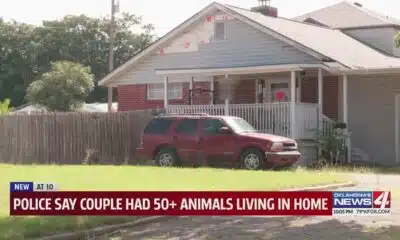News from the South - Oklahoma News Feed
Parole Rate on the Rise
SUMMARY: Oklahoma’s parole grant rate increased in 2024, with nearly 29% of prisoners receiving favorable recommendations, up from 24% in 2023. This follows a period of declining parole approvals, which coincided with rising prison populations after the COVID-19 pandemic. Violent offenders remain less likely to receive parole, though the rate of those granted stage-two reviews has increased. The parole board faced leadership changes in late 2023, with vacancies remaining after the resignation of key members. Justice reform advocates argue for a full-time board to improve parole decisions, especially for violent offenders, with potential legislative changes in 2025.
The post Parole Rate on the Rise appeared first on oklahomawatch.org
News from the South - Oklahoma News Feed
Young photographer shoots for free, dedicated to his craft
SUMMARY: Hunter Shepard, a passionate young photographer from Oklahoma, captures high school sports moments for free, traveling across the state on his own dime. Despite being autistic and having ADHD, Hunter has an incredible memory and deep knowledge of sports. He takes professional-quality action shots and posts them online, only asking for donations. His kindness and dedication earned him recognition from Oklahoma’s News 4 “Pay It Forward” program. Surprised with \$400 for equipment and travel costs, Hunter humbly accepted the gift, emphasizing his love for photography and helping others preserve cherished memories of their “glory years” through his lens.
Young photographer shoots for free, dedicated to his craft
News from the South - Oklahoma News Feed
Oklahoma Has Nation’s Highest Average Homeowners Insurance Premiums
After Oklahoma Watch debunked a claim that hail explained skyrocketing homeowners insurance rates, Oklahoma Insurance Department Commissioner Glen Mulready — who amplified the hail claims — backtracked in a statement published on the department’s website entitled “It’s Not Just Hail: A Look Into Oklahoma Homeowners Rates.”
According to a June 9 Lending Tree report, Oklahoma has the highest average homeowners insurance premium in the country at $6,133 per year, 2.2 times the national average of $2,801. Rates in Oklahoma have climbed 50.8% from 2019, the year Mulready took office, through 2024, rising faster than the national average of 40.4% the report said.
Mulready explained that insurance rates are driven by a combination of factors beyond hail, and championed the work of the department on behalf of consumers.
A new Oklahoma Watch investigation revealed some of these claims to be dubious.
A False Claim
Mulready said that the department fields complaints, enforces laws, and ensures that companies treat consumers fairly.
“We take action to protect consumers when insurers act illegally or violate contracts,” Mulready said.
Mulready said that $12 million was returned to consumers in 2024 by the Consumer Assistance/Claims Division of the OID. However, the Consumer Assistance/Claims Division has no impact on homeowners rates as set by insurance companies.
Mulready said that Oklahoma law prevents the OID from interfering on rates.
“OID has no statutory authority to set or approve homeowners rates except in certain, extraordinary circumstances,” Mulready said.
He went on to claim that 38 states follow a similar model.
That is false.
Mulready ignored the fact that Oklahoma’s tornado alley neighbors, Texas and Kansas, which by various measures enjoy lower homeowners insurance rates while suffering from weather conditions similar to or worse than Oklahoma, follow the same model but do in fact perform regulatory work to approve rates.
The difference is the role of actuaries, the number crunchers of the insurance world.
The Last of the Actuaries
“What I’ve found is that most people have not heard of us,” said Thomas Cummins, 83, who as far as he knows is the only independent actuary left in the state of Oklahoma.
Originally from Duncan, Cummins studied math at Oklahoma State University, but had to go to the University of Iowa to study actuarial science, which he defined as the effort to measure the financial impact of certain occurrences on financial markets or people.
Actuaries are financial statisticians, Cummins said. When they are employed by an insurance company, their role is to ensure that the company has enough money to cover claims on the policies they have written.
Cummins said there are about 30,000 actuaries in the United States, but he was aware of only three in Oklahoma: an actuary who lives in Tulsa but does most of his work in California, another actuary who is employed by Blue Cross Blue Shield, and Cummins himself, in business since 1981 and the last independent actuary working in the state, as far as he knows.
!function(){“use strict”;window.addEventListener(“message”,function(a){if(void 0!==a.data[“datawrapper-height”]){var e=document.querySelectorAll(“iframe”);for(var t in a.data[“datawrapper-height”])for(var r,i=0;r=e[i];i++)if(r.contentWindow===a.source){var d=a.data[“datawrapper-height”][t]+”px”;r.style.height=d}}})}();
Kim Holland, who served as Oklahoma’s insurance commissioner from 2005 to 2011, recalled that an actuary had been employed on the health side of the department during her tenure, but at that time there was no actuary on the property and casualty side, which included homeowners insurance.
Today, OID does employ a chief actuary. According to OID’s 2024 annual report, the chief actuary is Andy Schallhorn, who is also the deputy commissioner in charge of the financial division. Schallhorn’s job is described as monitoring the financial solvency of insurance companies and working to ensure compliance with Oklahoma law.
Oklahoma law is the problem.
The Devil in the Details
Mulready’s claim that Oklahoma’s insurance model matched that of 38 other states ignored significant state-to-state variety.
“All states have different regulatory requirements and prerogatives that vary on the needs and dynamics of that particular state,” Holland said.
Rich Gibson of the American Academy of Actuaries said what Mulready likely meant was that 38 states operate on what’s known as a file-and-use model.
File-and-use means insurance companies file rate changes and put them into use immediately to charge customers; states that scrutinize rate filings before they are put into use are known as prior approval states.
That’s where it gets tricky, because there are significant differences that separate file-and-use states.
In Texas and Kansas, when filings are put into use, actuaries immediately review them to ensure that rates are adequate (to protect insurance companies), not excessive (to protect consumers), or unfairly discriminatory.
The critical difference: Oklahoma does not examine rates to protect consumers. In fact, Oklahoma law prevents the Insurance Department from protecting consumers by ensuring that rates are not excessive.
“OID has no statutory authority to set or approve homeowners rates except in certain, extraordinary circumstances.”
Glen Mulready
When Mulready said that Oklahoma may set or approve rates only in extraordinary circumstances, he was not citing a similarity between Oklahoma and other states; rather, he was referencing a significant distinction between Oklahoma and its file-and-use, tornado alley neighbors.
Specifically, the automatic process of actuarial scrutiny in Texas and Kansas is applied to every rate filing. By way of contrast, Oklahoma can scrutinize rate filings only if the commissioner has previously found the market to be non-competitive.
As Oklahoma Watch documented in its original investigation, the process for declaring a non-competitive market is legally murky and not widely understood; it’s unclear whether the state’s lone 2016 invocation of the non-competitive market statute was fully legal.
Also unclear is the precise job of the chief actuary. The 2024 annual report made a brief reference to the chief actuary protecting consumers, but how the actuary can protect consumers when the law prevents scrutiny of excessive rates is an open question.
In response to an interview request, Mulready cited dissatisfaction with Oklahoma Watch’s original story. He indicated that he had instructed the public agency’s staff to no longer engage with Oklahoma Watch.
“We will not be participating in this story,” Mulready said in an email.
Texas and Kansas Save Consumers Millions
The Texas Department of Insurance employs 18 actuaries to review rate filings, of whom 12 are dedicated to scrutinizing an annual average of 3,000 property and casualty filings, which include homeowners insurance.
Texas Department of Insurance actuaries submit questions to insurance companies or request changes on approximately 75% of filings; 10% of filings are withdrawn or rejected.
Since 2021, actuarial review of filings has saved Texas consumers $131.7 million, a TDI spokesman said in a written statement.
The Kansas Insurance Department employs a Chief of Actuarial Services and utilizes a pool of consulting actuaries to evaluate hundreds of property and casualty rate filings annually, said KID Deputy Chief of Staff Kyle Strathman.
Filings are evaluated for rate reasonableness, to ensure that rates are not excessive, inadequate or unfairly discriminatory.
“If a filing is found to be out of compliance, the carrier is required to make an adjustment to the filing,” Strathman said, while declining to provide a precise dollar estimate on what the rate review process saves consumers each year.
It’s not Just Homeowners Insurance
Rather than encouraging competition by advising consumers to discriminate and shop among insurance companies, an I-44 billboard featuring Commissioner Mulready’s face alongside images of severe weather incidents sends a dire message: you can’t fight higher rates, so batten down the hatches and ride out the storm.
The problem of rising property insurance rates extends beyond homeowners insurance.
Sherie Donahay, president of the Bradbury Corner Homeowners’ Association in Edmond, reached out to OID to complain when the association’s rates skyrocketed despite the fact that Bradbury Corner had few assets to insure.
“I know the policy had doubled since 2023,” Donahay said, adding that she was aware of rate increases at other HOAs as well.
Donahay expressed her concern to OID that Bradbury Corner was being used to cover costs in other states where there were huge homeowners associations.
“I continue to see record profits on Wall Street by insurance companies.”
Keith Easley
In 2023, Sasakwa Public Schools Superintendent Kyle Wilson was featured in a story about rapidly rising property insurance rates for schools; Wilson fretted over whether out-of-control rate hikes would affect his ability to hire much-needed teachers.
Since then, Wilson said, rates had continued to rise for Sasakwa Public Schools; the anticipated 2026 rate of $151,000 was more than three times the 2020 rate of $45,000.
Insurance Companies Review Themselves, Actually
Oklahoma law does require insurance companies to submit an annual statement of actuarial opinion; however, the statement, by law, is authored by the company’s own appointed actuary.
In Oklahoma, insurance companies review themselves, actually.
Former commissioner Holland noted that during her tenure OID worked to clean up old regulations, and interacted with lawmakers constantly to suggest legislative changes.
Holland recalled that she had support from both political parties during her time in office. It helped that she had worked in insurance her whole career; she wasn’t hostile to the industry, but continued to believe that oversight was necessary.
“Do I think they need to be held accountable?” Holland said. “I did then, and I do now.”
In Oklahoma Watch’s original investigation, former legislator Kevin Easley, who championed a law that was later warped into the statutes that now govern homeowners insurance, spoke passionately about the changes to the legislation he had helped pass.
“They can damn sure change it back, can’t they?” Easley said at the time.
Now an oil and gas executive, Easley seconded Holland’s nostalgia for a time when agency heads worked closely with lawmakers to make problem-solving recommendations.
Easley was unimpressed with Mulready’s description of Oklahoma’s insurance model. Regardless of whether the model was similar to other states, Easley doubted whether 38 states were having the same kinds of problems Oklahoma is having.
“I continue to see record profits on Wall Street by insurance companies,” Easley said. “If the model in Oklahoma does not provide the authority to get involved in setting rates that are market-based, then maybe Mulready needs to be recommending to the legislature that the model be changed. If the model isn’t working, we should be changing the model.”
This article first appeared on Oklahoma Watch and is republished here under a Creative Commons Attribution-NoDerivatives 4.0 International License.
The post Oklahoma Has Nation’s Highest Average Homeowners Insurance Premiums appeared first on oklahomawatch.org
Oklahoma Watch, at oklahomawatch.org, is a nonprofit, nonpartisan news organization that covers public-policy issues facing the state.
Note: The following A.I. based commentary is not part of the original article, reproduced above, but is offered in the hopes that it will promote greater media literacy and critical thinking, by making any potential bias more visible to the reader –Staff Editor.
Political Bias Rating: Left-Leaning
This article from Oklahoma Watch presents a critical examination of Insurance Commissioner Glen Mulready’s claims and the broader policy framework governing homeowners insurance in Oklahoma. While it cites factual data and sources, the language and framing—such as labeling Mulready’s statements as “false,” using pointed headlines like “Insurance Companies Review Themselves, Actually,” and concluding with statements emphasizing corporate profits—indicate a skeptical stance toward deregulated markets and industry-friendly policy. The article implicitly advocates for stronger regulatory oversight, aligning with policy preferences typically associated with the political left, thus suggesting a left-leaning bias in tone and presentation.
News from the South - Oklahoma News Feed
FEMA pulls back funding for Norman's flood alert system
SUMMARY: FEMA has abruptly withdrawn funding promised to Norman, Oklahoma, for a life-saving flood warning system. The federal government labeled the grant program supporting this project as wasteful and ineffective, despite its potential to prevent tragedies like recent deadly floods in Texas. Norman faces losing $350,000 vital to building the early detection system, with officials struggling to find alternative resources. Local leaders, including Senator Mary Boren, criticize the decision as politically motivated and detrimental to community safety. Meanwhile, the city emphasizes its ongoing commitment to public safety through existing monitoring methods while seeking new funding to advance flood preparedness.
FEMA pulls back funding for Norman’s flood alert system
Stay informed about Oklahoma news and weather! Follow KFOR News 4 on our website and social channels.
https://kfor.com/
https://www.youtube.com/c/kfor4news
https://www.facebook.com/kfor4
https://twitter.com/kfor
https://www.instagram.com/kfortv4/
-
News from the South - Tennessee News Feed5 days ago
Bread sold at Walmart, Kroger stores in TN, KY recalled over undeclared tree nut
-
News from the South - Arkansas News Feed7 days ago
Man shot and killed in Benton County, near Rogers
-
News from the South - Georgia News Feed1 day ago
Aiken County family fleeing to Mexico due to Trump immigration policies
-
News from the South - Alabama News Feed6 days ago
Girls Hold Lemonade Stand for St. Jude Hospital | July 12, 2025 | News 19 at 10 p.m. – Weekend
-
News from the South - Georgia News Feed7 days ago
Anti-ICE demonstrators march to Beaufort County Sheriff's Office
-
News from the South - Oklahoma News Feed7 days ago
Police say couple had 50+ animals living in home
-
Mississippi Today4 days ago
Coast judge upholds secrecy in politically charged case. Media appeals ruling.
-
Local News5 days ago
Oyster spawning begins as MDMR-USM Hatchery Program enters production phase using mobile hatchery










































